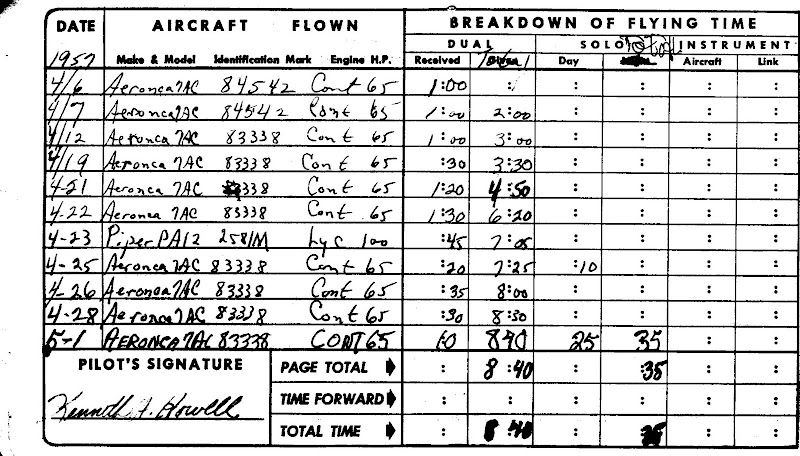CFI1513840
Well Known Member
The sign said ?Learn to Fly - $80?. It was posted near the entrance to the North Biloxi airport, a small grass strip not too far from the sprawling Keesler Air Force Base in Mississippi. The year was 1957. How could a seventeen-year old E3 with a few bucks in his pocket pass up such an opportunity? It turned out that learning to fly meant going solo, after that more cash was needed. Still, it wasn?t a bad deal.
April 21, 1957. Sitting in the front of N84542, an Aeronca 7AC, I listened to Art Homer shouting at me from the back seat. No headsets or intercom in those days. It was one-way communication. Art, former potato farmer and crop duster, was hard of hearing on the ground and essentially deaf when airborne. He may have had a hearing aid, but if he did, I?m sure he turned off while aloft. That day the throttle linkage came off while practicing glides. I had a hard time explaining to Art why I wasn?t advancing the power after descending to about 500? AGL. Finally I got the point across by pointing to the throttle and flopping it back and forth a few times. Art took over and landed on a narrow country road, which was free of traffic, but with a fair share of trees and telephone poles on each side. The little Air-knocker had its wings badly dented, but we exited without a scratch.
Art didn?t want to give me too much time to mull things over and worry about forced landings, or worst of all, to quit flying. So two hours later, after arranging transport back to the airport for us and the Air-knocker, we were back up in another 7AC, this time N83338. Interestingly, Art?s endorsement of the flights that day makes no mention of our ?incident?, or even that we flew N84542, as if he wanted to pretend it never happened. I had lost my innocence, but thanks to Art?s persuasive methods, not my nerve - at least not entirely. After that, during every pre-flight, I made darn sure the throttle linkage was securely connected, being blissfully ignorant of all the other million and a half things that could go wrong.

April 21, 1957. Sitting in the front of N84542, an Aeronca 7AC, I listened to Art Homer shouting at me from the back seat. No headsets or intercom in those days. It was one-way communication. Art, former potato farmer and crop duster, was hard of hearing on the ground and essentially deaf when airborne. He may have had a hearing aid, but if he did, I?m sure he turned off while aloft. That day the throttle linkage came off while practicing glides. I had a hard time explaining to Art why I wasn?t advancing the power after descending to about 500? AGL. Finally I got the point across by pointing to the throttle and flopping it back and forth a few times. Art took over and landed on a narrow country road, which was free of traffic, but with a fair share of trees and telephone poles on each side. The little Air-knocker had its wings badly dented, but we exited without a scratch.
Art didn?t want to give me too much time to mull things over and worry about forced landings, or worst of all, to quit flying. So two hours later, after arranging transport back to the airport for us and the Air-knocker, we were back up in another 7AC, this time N83338. Interestingly, Art?s endorsement of the flights that day makes no mention of our ?incident?, or even that we flew N84542, as if he wanted to pretend it never happened. I had lost my innocence, but thanks to Art?s persuasive methods, not my nerve - at least not entirely. After that, during every pre-flight, I made darn sure the throttle linkage was securely connected, being blissfully ignorant of all the other million and a half things that could go wrong.





